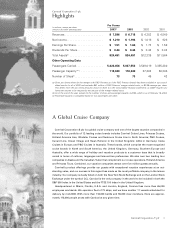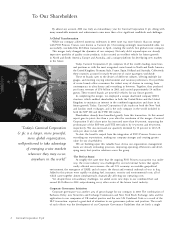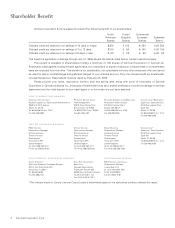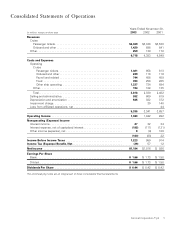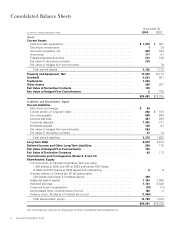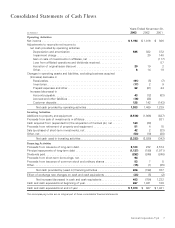Carnival Cruises 2003 Annual Report Download - page 13
Download and view the complete annual report
Please find page 13 of the 2003 Carnival Cruises annual report below. You can navigate through the pages in the report by either clicking on the pages listed below, or by using the keyword search tool below to find specific information within the annual report.
10 Carnival Corporation & plc
Preparation of Financial Statements
The preparation of our consolidated financial state-
ments in accordance with accounting principles gener-
ally accepted in the United States of America requires
us to make estimates and assumptions that affect the
amounts reported and disclosed in our financial state-
ments. Actual results could differ from these estimates.
All material intercompany accounts, transactions and
unrealized profits and losses on transactions within
our consolidated group and with affiliates are elimi-
nated in consolidation.
Commencing in 2003, we changed the reporting
format of our consolidated statements of operations
to present our significant revenue sources and their
directly related variable costs and expenses. In addition,
we have separately identified certain ship operating
expenses, such as payroll and related expenses and
food costs. All prior periods were reclassified to con-
form to the current year presentation.
Note 2—Summary of Significant Accounting Policies
Basis of Presentation
We consolidate entities over which we have control,
as typically evidenced by a direct ownership interest of
greater than 50%. For affiliates where significant influ-
ence over financial and operating policies exists, as typ-
ically evidenced by a direct ownership interest from 20%
to 50%, the investment is accounted for using the equity
method. See Note 6.
Cash and Cash Equivalents and Short-Term
Investments
Cash and cash equivalents include investments with
original maturities of three months or less, which are
stated at cost. At November 30, 2003 and 2002, cash
and cash equivalents included $937 million and $616
million of investments, respectively, primarily comprised
of strong investment grade asset-backed debt obliga-
tions, commercial paper and money market funds.
Short-term investments are comprised of marketable
debt and equity securities which are categorized as
available for sale and, accordingly, are stated at their
fair values. Unrealized gains and losses are included
as a component of accumulated other comprehensive
income (“AOCI”) within shareholders’ equity until real-
ized. The specific identification method is used to
determine realized gains or losses.
Inventories
Inventories consist primarily of provisions, gift shop
and art merchandise held for resale, spare parts, sup-
plies and fuel carried at the lower of cost or market.
Cost is determined using the weighted-average or first-
in, first-out methods.
Property and Equipment
Property and equipment are stated at cost. Deprecia-
tion and amortization were computed using the straight-
line method over our estimates of average useful lives
and residual values, as a percentage of original cost,
as follows:
Residual
Values Years
Ships . . . . . . . . . . . . . . . . . . . . . 15% 30
Buildings and improvements . . . . 0–10% 5–40
Transportation equipment
and other . . . . . . . . . . . . . . . . 0–25% 2–20
Leasehold improvements,
including port facilities. . . . . . . Shorter of lease
term or related
asset life
We review our long-lived assets for impairment
whenever events or changes in circumstances indicate
that the carrying amount of these assets may not be
fully recoverable. The assessment of possible impair-
ment is based on our ability to recover the carrying
value of our asset based on our estimate of its undis-
counted future cash flows. If these estimated undis-
counted future cash flows are less than the carrying
value of the asset, an impairment charge is recognized
for the excess, if any, of the assets carrying value over
its estimated fair value (see Note 5).
Dry-dock costs are included in prepaid expenses and
are amortized to other ship operating expenses using
the straight-line method generally over one year.
Ship improvement costs that we believe add value to
our ships are capitalized to the ships, and depreciated
over the improvements’ estimated useful lives, while
costs of repairs and maintenance are charged to expense
as incurred. We capitalize interest on ships and other
capital projects during their construction period. Upon
the replacement or refurbishment of previously capital-
ized ship components, these assets’ estimated cost
and accumulated depreciation are written-off and any
resulting loss is recognized in our results of operations.
No such material losses were recognized in fiscal 2003,
2002 or 2001. See Note 4.
Goodwill
Statement of Financial Accounting Standards (“SFAS”)
No. 142, “Goodwill and Other Intangible Assets” requires
companies to stop amortizing goodwill and requires an
annual, or when events or circumstances dictate, a more
frequent, impairment review of goodwill. Accordingly,
upon adoption of SFAS No. 142 on December 1, 2001,
we ceased amortizing our goodwill, all of which had
been allocated to our cruise reporting units. In April
2003, we recorded $2.25 billion of additional goodwill
Notes to Consolidated Financial Statements (continued)



